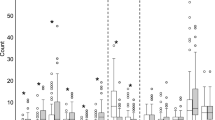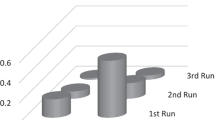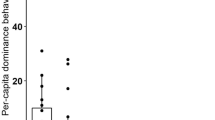Abstract
In order to elucidate the dominant–subordinate relationship between the foundress and workers, five colonies of the paper wasp Polistes japonicus were observed in a netted and covered cage located outdoors. The number of workers in each colony ranged from four to eight. Workers were divided into first and second broods. Abdominal wagging and ovipositing were performed almost exclusively by the foundress throughout colony development. However, an analysis of aggressive encounters indicated that although the foundress hardly received dominance behaviors (aggression) from workers, it lacked either partially or completely the following characteristics of the queen that are usually seen in paper-wasp colonies with independent-founding queens (except in one colony that produced no second brood): the queen being socially dominant over any worker (the queen had more wins than losses in one-on-one dominance contests with any worker), exhibiting the highest frequency of dominance behaviors, and directing dominance behaviors primarily toward the socially most-dominant worker. In particular, during the mixed-brood period (when all first- and second-brood workers were present on the nest) the foundress hardly exhibited dominance behaviors toward socially dominant workers (mainly second brood) but frequently directed dominance behaviors toward socially subordinate workers (mainly first brood). The foundress disappeared in two colonies before the reproductives emerged; in these colonies the socially most-dominant worker inherited the colony and laid many eggs. The frequency of abdominal wagging by these two foundresses decreased during colony development, while it did not in the other colonies. This suggests that abdominal wagging provides information about the vigor of the performer. The superseder was socially dominant over all other workers, but spent little time wagging its abdomen and allowed some workers to lay eggs.






Similar content being viewed by others
References
Bhadra A., Iyer P.L., Sumana A., Deshpande S.A., Ghosh S. and Gadagkar R. 2007. How do workers of the primitively eusocial wasp Ropalidia marginata detect the presence of their queens? J. Theor. Biol. 246: 574-582
Breed M.D. and Gamboa G.J. 1977. Behavioral control of workers by queens in primitively eusocial bees. Science 195: 694-696
Bridge C. and Field J. 2007. Queuing for dominance: gerontocracy and queue-jumping in the hover wasp Liostenogaster flavolineata. Behav. Ecol. Sociobiol. 61: 1253-1259
Brillet C., Tian-Chansky S.S. and Le Conte Y. 1999. Abdominal waggings and variation of their rate of occurrence in the social wasp, Polistes dominulus (Christ) I. Quantitative analysis. J. Insect Behav. 12: 665-686
Bruyndonckx N., Kardile S.P. and Gadagkar R. 2006. Dominance behavior and regulation of foraging in the primitively eusocial wasp Ropalidia marginata (Lep.) (Hymenoptera: Vespidae). Behav. Proc. 72: 100-103
Cant M.A., Llop J.B. and Field J. 2006. Individual variation in social aggression and the probability of inheritance: theory and a field test. Am. Nat. 167: 837-852
Chandrashekara K. and Gadagkar R. 1991. Behavioural castes, dominance and division of labour in a primitively eusocial wasp. Ethology 87: 269-283
Chandrashekara K. and Gadagkar R. 1992. Queen succession in the primitively eusocial tropical wasp Ropalidia marginata (Lep.) (Hymenoptera: Vespidae). J. Insect Behav. 5: 193-209
Cummings D.L.D., Gamboa G.J. and Harding B.J. 1999. Lateral vibrations by social wasps signal larvae to withhold salivary secretions (Polistes fuscatus, Hymenoptera: Vespidae). J. Insect Behav. 12: 465-473
Downing H.A. and Jeanne R.L. 1985. Communication of status in the social wasp Polistes fuscatus (Hymenoptera: Vespidae). Z. Tierpsychol. 67: 78-96
Field J. and Cant M. 2006. Helping effort in primitively eusocial wasps. Ann. Zool. Fenn. 43: 481-487
Field J., Cronin A. and Bridge C. 2006. Future fitness and helping in social queues. Nature 441: 214-217
Gadagkar R. 1980. Dominance hierarchy and division of labour in the social wasp Ropalidia marginata (Lep.) (Hymenoptera: Vespidae). Curr. Sci. 49: 772-775
Gadagkar R. 2001. The Social Biology of Ropalidia marginata: Toward Understanding the Evolution of Eusociality. Harvard University Press, Cambridge
Gadagkar R. 2009. Interrogating an insect society. Proc. Natl. Acad. Sci. USA 106: 10407-10414
Hughes C.R. and Strassmann J.E. 1988. Age is more important than size in determining dominance among workers in the primitively eusocial wasp, Polistes instabilis. Behaviour 107: 1-15
Ishikawa Y., Yamada Y.Y., Matsuura M., Tsukada M. and Tsuchida K. 2010. Dominance hierarchy among workers changes with colony development in Polistes japonicus (Hymenoptera, Vespidae) paper wasp colonies with a small number of workers. Insect. Soc. 57: 465-475
Jeanne R.L. 1972. Social biology of the neotropical wasp Mischocyttarus drewseni. Bull. Mus. Comp. Zool. 144: 63-150
Jeanne R.L. 2003. Social complexity in the Hymenoptera, with special attention to the wasps. In: Genes, Behaviors and Evolution of Social Insects (Kikuchi T., Azuma N. and Higashi S., Eds), Hokkaido University Press, Sapporo. pp 81-131
Jeanne R.L. 2009. Vibrational signals in social wasps: a role in caste determination? In: Organization of Insect Societies: from Genome to Sociocomplexity (Gadau J. and Fewell J., Eds), Harvard University Press, Cambridge. pp 243-265
Keller L. and Nonacs P. 1993. The role of queen pheromones in social insects: queen control or queen signal? Anim. Behav. 45: 787-794
Lamba S., Chandrasekhar K. and Gadagkar R. 2008. Signaling hunger through aggression - the regulation of foraging in a primitively eusocial wasp. Naturwissenschaften 95: 677-680
Litte M. 1977. Behavioral ecology of the social wasp, Mischocyttarus mexicanus. Behav. Ecol. Sociobiol. 2: 229-246
Matsuura M. 1995. General remarks on the Japanese social wasps: Polistinae. In: Social Wasps of Japan in Color. Hokkaido University Press, Sapporo. pp 309-322 (in Japanese)
Miyano S. 1986. Colony development, worker behavior and male production in orphan colonies of a Japanese paper wasp, Polistes chinensis antennalis Pérez (Hymenoptera: Vespidae). Res. Popul. Ecol. 28: 347-361
Molina Y. and O’Donnell S. 2009. Worker reproductive competition affects division of labor in a primitively social paperwasp (Polistes instabilis). Insect. Soc. 56: 14-20
Monnin T. and Peeters C. 1999. Dominance hierarchy and reproductive conflicts among subordinates in a monogynous queenless ant. Behav. Ecol. 10: 323-332
O’Donnell S. 1998. Effects of experimental forager removals on division of labour in the primitively eusocial wasp Polistes instabilis (Hymenoptera: Vespidae). Behaviour 135: 173-193
Pardi L. 1948. Dominance order in Polistes wasp. Physiol. Zool. 21: 1-13
Peeters C. and Liebig J. 2009. Fertility signaling as a general mechanism of regulating reproductive division of labor in ants. In: Organization of Insect Societies: from Genome to Sociocomplexity (Gadau J. and Fewell J., Eds), Harvard University Press, Cambridge. pp 220-242
Premnath S., Sinha A. and Gadagkar R. 1996. Dominance relationship in the establishment of reproductive division of labour in a primitively eusocial wasp (Ropalidia marginata). Behav. Ecol. Sociobiol. 39: 125-132
Reeve H.K. 1991. Polistes. In: The Social Biology of Wasps (Ross K.G. and Matthews R.W., Eds), Comstock Publishing Associates, A division of Cornell University Press, London. pp 99-148
Reeve H.K. and Gamboa G.J. 1987. Queen regulation of worker foraging in paper wasps: a social feedback control system (Polistes fuscatus, Hymenoptera: Vespidae). Behaviour 102: 147-167
Rice W.R. 1989. Analyzing tables of statistical tests. Evolution 43: 223-225
Röseler P.-F. 1991. Reproductive competition during colony establishment. In: The Social Biology of Wasps (Ross K.G. and Matthews R.W., Eds), Comstock Publishing Associates, A division of Cornell University Press, London. pp 309-335
Sledge M.F., Boscaro F. and Turillazzi S. 2001. Cuticular hydrocarbons and reproductive status in the social wasp Polistes dominulus. Behav. Ecol. Sociobiol. 49: 401-409
Spradbery J.P. 1991. Evolution of queen number and queen control. In: The Social Biology of Wasps (Ross K.G. and Matthews R.W. Eds), Comstock Publishing Associates, A division of Cornell University Press, London. pp 336-388
Strauss K., Scharpenberg H., Crewe R.M., Glahn F., Foth H. and Moritz R.F.A. 2008. The role of the queen mandibular gland pheromone in honeybees (Apis mellifera): honest signal or suppressive agent? Behav. Ecol. Sociobiol. 62: 1523-1531
Sumana A. and Gadagkar R. 2001. The structure of dominance hierarchies in the primitively eusocial wasp Ropalidia marginata. Ethol. Ecol. Evol. 13: 273-281
Suryanarayanan S., Hantschel A.E., Torres C.G. and Jeanne R.L. 2011. Changes in the temporal pattern of antennal drumming behavior across the Polistes fuscatus colony cycle (Hymenoptera, Vespidae). Insect. Soc. 58: 97-106
Wenseleers T. and Ratnieks F.L.W. 2006. Comparative analysis of worker reproduction and policing in eusocial Hymenoptera supports relatedness theory. Am. Nat. 168: E163-E179
West-Eberhard M.J. 1978. Temporary queens in Metapolybia wasps: non-reproductive helpers without altruism? Science 200: 441-443
West-Eberhard M.J. 1981. Intragroup selection and the evolution of insect societies. In: Natural Selection and Social Behavior: Research and New Theory (Alexander R.D. and Tinkle D.W., Eds), Chiron Press, New York. pp 3-17
Wilson E.O. 1974. Group effects and the control of nestmates. In: The Insect Societies. Harvard University Press, Cambridge. pp 296-305
Yamane S. 1986. The colony life cycle of the Sumatran paper wasp Ropalidia (Icariola) variegata jacobsoni (Buysson). With reference to the possible occurrence of serial polygyny (Hymenoptera: Vespidae). Monit. Zool. Ital. 20: 135-161
Acknowledgments
We thank R.L. Jeanne and an anonymous referee for helpful comments on the manuscript.
Author information
Authors and Affiliations
Corresponding author
Rights and permissions
About this article
Cite this article
Ishikawa, Y., Yamada, Y.Y., Matsuura, M. et al. Polistes japonicus (Hymenoptera, Vespidae) queens monopolize ovipositing but are not the most active aggressor in dominant-subordinate interactions. Insect. Soc. 58, 519–529 (2011). https://doi.org/10.1007/s00040-011-0173-y
Received:
Revised:
Accepted:
Published:
Issue Date:
DOI: https://doi.org/10.1007/s00040-011-0173-y




